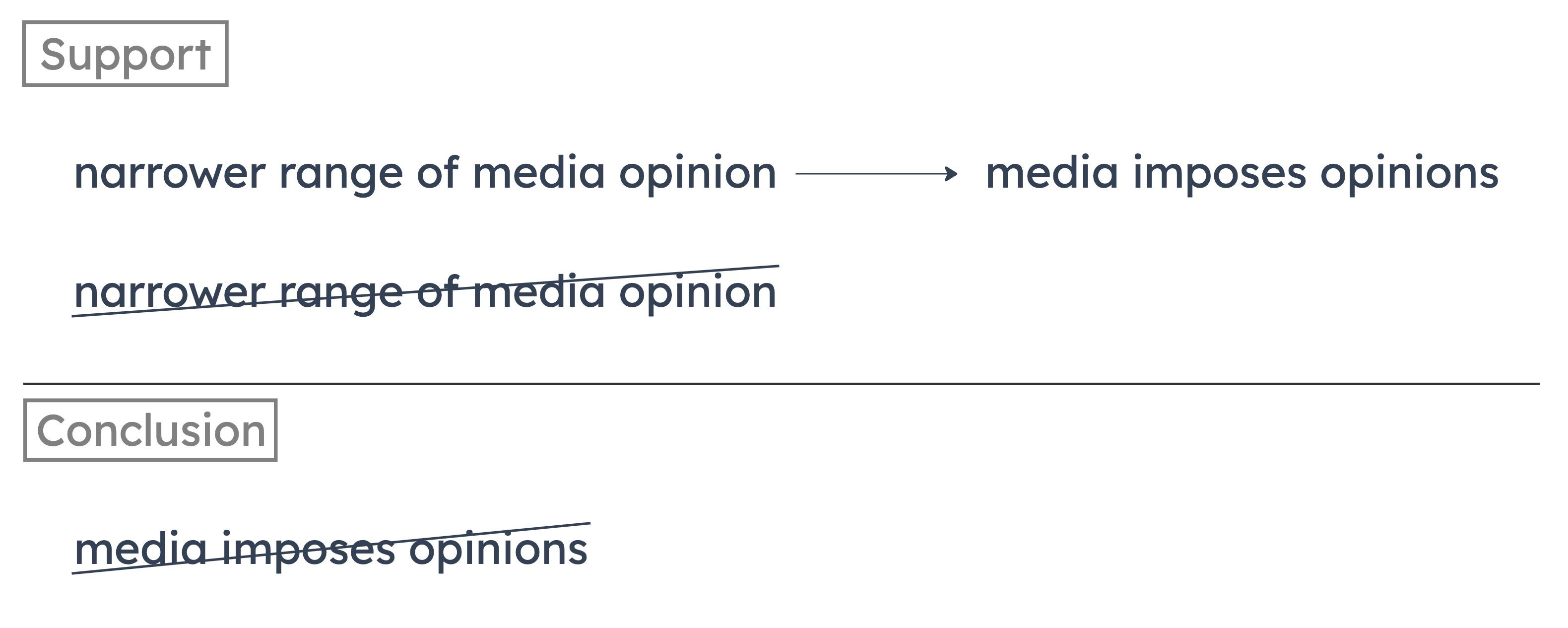Maria: Yes, Reade is the most popular. However, you are incorrect in claiming that this is because of Reade’s discussion of complex campaign issues. Reade simply strikes the voters as the most competent and trustworthy candidate.
Summarize Argument
Maria concludes that Reade isn’t ahead in the polls because of her discussion of complex campaign issues. Instead, Reade is ahead because voters think she’s the most competent and trustworthy candidate.
Notable Assumptions
Since Maria believes Reade is ahead because voters view her as the most competent and trustworthy candidate, Maria assumes competence and trustworthiness outweigh discussions of complex campaign issues for voters.
A
Reade’s opponents are discussing some of the same issues as Reade.
Even if they’re discussing these issues, voters may evaluate their stances to be inferior to Reade’s. We need something that tells us voters care less about such discussions than they care about competence and trustworthiness.
B
Reade’s opponents charge that Reade oversimplifies complex campaign issues.
We don’t care what Reade’s opponents think.
C
Polling data show that Reade’s present popularity will probably diminish over time.
We don’t care what will happen to Reade’s popularity later on. Maria is arguing about why she’s ahead right now.
D
Polling data show that most voters cannot identify Reade’s positions on campaign issues.
Since voters can’t identify Reade’s positions on campaign issues, they evidently haven’t been paying too much attention to her discussion of such issues. This means Reade must be ahead in the polls for some other reason, such as the one Maria gives.
E
Polling data show that some voters consider Reade competent and trustworthy.
“Some” could be mean 5%. This certainly wouldn’t put Reade ahead in the polls.
Summarize Argument: Counter-Position
The author concludes that the media does not have excessive power to impose opinions, contrary to the view of some critics. His support is that, if the media purveyed an overly narrow range of opinion, that would be sufficient for it to impose opinions. But it doesn’t purvey an overly narrow range of opinion.


Identify and Describe Flaw
This is the cookie-cutter flaw of confusing sufficiency and necessity. The author argues that, because a sufficient condition (overly restricted opinion) isn’t true, its necessary condition (imposing opinions) couldn’t be true. This is flawed reasoning, because only the absence of a necessary condition (not a sufficient condition) can tell you that something can’t be true.
Consider the analogous argument: “If this food was an orange, it would be a fruit. It’s not an orange, so it can’t be a fruit.” This is fallacious, because even though being an orange is enough to make something a fruit, not all fruits are oranges.
Consider the analogous argument: “If this food was an orange, it would be a fruit. It’s not an orange, so it can’t be a fruit.” This is fallacious, because even though being an orange is enough to make something a fruit, not all fruits are oranges.
A
The argument launches a personal attack against the critics rather than addressing the reasons they present in support of their claim.
This is the cookie-cutter flaw of ad hominem. It isn’t applicable here, because there is no personal attack; the author provides a substantive argument.
B
The argument takes for granted that the media give at least as much exposure as they should to a wide range of opinion on the important issues of the day.
The author would be taking this for granted if he were to assume it was true without actually stating it. He explicitly says that it is true, so he isn’t taking it for granted.
C
The argument takes for granted that if the truth of one claim implies the truth of a second claim, then the falsity of the first claim proves the falsity of the second claim.
This is the cookie-cutter flaw of confusing necessary and sufficient conditions (see diagram above). The author argues that a sufficient condition doesn’t apply, so its necessary condition doesn’t apply either. But that doesn’t follow logically.
D
The argument, instead of providing adequate reasons in support of its conclusion, makes an appeal to popular opinion.
The author’s conclusion is about people’s opinions, but he doesn’t appeal to popular opinion. That would be if he’d said that many people believe this conclusion is true, so therefore it must be true.
E
The argument takes for granted that it is desirable for a wide range of opinion on the important issues of the day to receive media exposure.
The author never says that it is desirable to have a wide range of opinion—he only says that there is in fact a wide range of opinion.